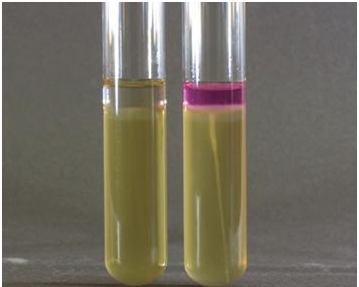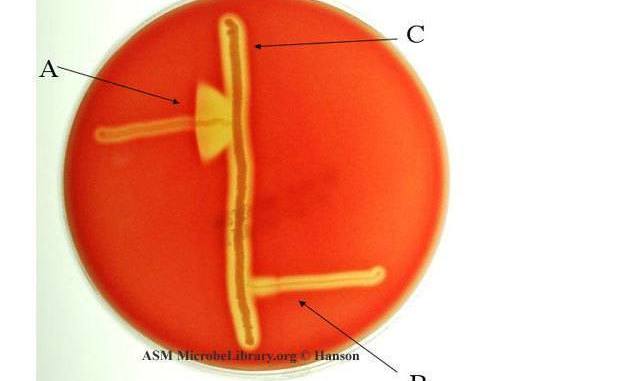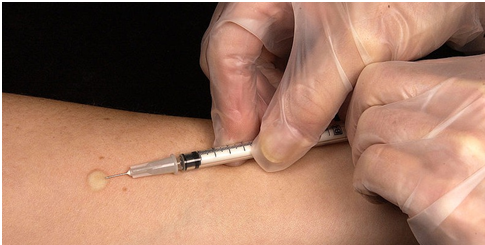Indole test (Tryptophan hydrolysis) is used to identify Enterobacteria that breakdown tryptophan (an amino acid) to produce indole. The indole test is a biochemical test performed on bacterial species to determine the ability of the organism to convert tryptophan into the indole.
Tryptophan hydrolysis is catalyzed by the enzyme tryptophanase to produce indole and pyruvic acid. Indole production is a characteristic feature of Enterobacteriaceae (e.g. Escherichia coli). Proteus vulgaris, Moraxella, and Providencia species are also indole positive.
Indole test is performed with a reagent called Kovac’s reagent that contains 4 (p)-dimethylamino benzaldehyde. Indole reacts with 4 (p)-dimethylamino benzaldehyde to produce a characteristic pink colouration which indicates a positive result.
In addition, the test culture is first cultured in a medium that contains tryptophan (e.g. peptone water) before performing the test.
PROCEDURE FOR INDOLE TEST
- Prepare peptone water by adding 10 g of tryptone or peptone to 100 ml of distilled water.
- Add 0.5 g of sodium to the peptone water solution.
- Adjust the final pH of the solution to 7.2.
- Dispense 5 ml portions of the solution into clean test tubes with caps and cover loosely.
- Sterilize in the autoclave and cool medium to 30oC. The tubes can be stored in the refrigerator until use.
- Inoculate the tube(s) with the test culture and incubate overnight at 37oC.
- Add 0.5 ml of Kovac’s reagent to each of the tube(s).
- Shake tube(s) gently and allow standing.
- Examine tube(s) for the presence of pink-red colour in the surface layer of the tube(s) within 5 mins. Presence of pink-red colour on the surface layer of the tube is a positive test result (Figure 1). Negative tubes do not produce this colouration, and may remain colourless, amber, brown or green.

References
Basic laboratory procedures in clinical bacteriology. World Health Organization (WHO), 1991. Available from WHO publications, 1211 Geneva, 27-Switzerland.
Beers M.H., Porter R.S., Jones T.V., Kaplan J.L and Berkwits M (2006). The Merck Manual of Diagnosis and Therapy. Eighteenth edition. Merck & Co., Inc, USA.
Biosafety in Microbiological and Biomedical Laboratories. 5th edition. U.S Department of Health and Human Services. Public Health Service. Center for Disease Control and Prevention. National Institute of Health. HHS Publication No. (CDC) 21-1112.2009.
Cheesbrough M (2010). District Laboratory Practice in Tropical Countries. Part I. 2nd edition. Cambridge University Press, UK.
Cheesbrough M (2010). District Laboratory Practice in Tropical Countries. Part 2. 2nd edition. Cambridge University Press, UK.
Collins C.H, Lyne P.M, Grange J.M and Falkinham J.O (2004). Collins and Lyne’s Microbiological Methods. Eight edition. Arnold publishers, New York, USA.
Disinfection and Sterilization. (1993). Laboratory Biosafety Manual (2nd ed., pp. 60-70). Geneva: WHO.
Garcia L.S (2010). Clinical Microbiology Procedures Handbook. Third edition. American Society of Microbiology Press, USA.
Garcia L.S (2014). Clinical Laboratory Management. First edition. American Society of Microbiology Press, USA.
Fleming, D. O., Richardson, J. H., Tulis, J. I. and Vesley, D. (eds) (1995). Laboratory Safety: Principles and practice. Washington DC: ASM press.
Dubey, R. C. and Maheshwari, D. K. (2004). Practical Microbiology. S.Chand and Company LTD, New Delhi, India.
Gillespie S.H and Bamford K.B (2012). Medical Microbiology and Infection at a glance. 4th edition. Wiley-Blackwell Publishers, UK.
Discover more from Microbiology Class
Subscribe to get the latest posts sent to your email.




